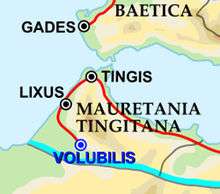Tingi

Tingi (current Tangier in Morocco) was an important Roman-Berber colonia in the Maghreb. The Berber name "Tingi" was adapted by the Romans into Tingis, after which the province of Mauretania Tingitana was named. Tingis also served as its capital.
History
The commercial Phoenician city of Thingis (Τιγγίς in Ancient Greek), came under Roman rule in the course of the 2nd century BC (146 BC). Later Tingi grew in importance first as a free city under Augustus, and then as a colony called Colonia Iulia Tingi under Claudius who made Tingis capital of Mauritania "Tingitana" of Hispania.[1]
Called Colonia Iulia Tingi on its coins, governed most likely under Latin law and at first attached administratively to Spain, it became under Claudius a Roman colony and chief city of the province of Mauretania Tingitana after it was set up. In 297 the city probably served Maximianus as a base during his campaign against the Moorish rebels, and it was very likely about this time that the Christians Marcellus and Cassienus were put to death. The former belonged to a Spanish community, the latter, however, probably to a local church which funerary inscriptions show existed in the 4th-5th c. although there is no mention of a bishopric until the 6th c.The limits of the ancient settlement are clearly marked by the necropoleis discovered to the NW (that of Marshan and Avenue Cenario), to the W (Mendoubia) and S (Bou Kachkach). Nothing remains of the substructures, which could still be seen on the seashore at the beginning of the century. There were also some baths underneath the Casbah, and confused remains of a monument—apparently a Christian basilica—have been uncovered in the Rue de Belgique. So far as the rest of the city is concerned one can only presume that the forum was situated on the site of the Petit Socco and what was perhaps a temple on the site of the Great Mosque, and that the decumanus maximus corresponded roughly to the Zenga Es Siaghine. Among the few antiquities that have been discovered, the only noteworthy finds, aside from inscriptions and a few mosaic fragments, are a statue of a woman of indifferent workmanship and a mutilated head of the emperor Galba.[2]
Since then Tingis grew greatly in importance and in the fourth century it was the main Roman city of Mauretania Tingitana, bypassing Volubilis after that city remained south of the Roman limes and no more protected by the Roman legions. The city in those years enjoyed huge development and importance, reaching 20,000 inhabitants (all fully romanized and mostly Christians).
Tingi was famous in the Roman empire because of the fishing conserve industry. Under Septimius Severus were built two Roman roads from Tingis: one on the Atlantic coast until Sala Colonia and the second in the mountainous interior toward Volubilis.
The Christian history of Tingis started during the second half of the first century, under emperor Claudius rule.[3] Originally, the city was part of the larger province of Mauretania Caesariensis, which included much of Northern Roman Africa. Later the area was subdivided, with the eastern part keeping the former name and the newer part receiving the name of Mauretania Tingitana. It is not known exactly at what period there may have been an episcopal see at Tangier in ancient times, but in the late Middle Ages Tangier was used as a titular see (i.e., an honorific fiction for the appointment of curial and auxiliary bishops), placing it in Mauretania Tingitana. For the historical reasons given above, one official list of the Roman Curia places the see in Mauretania Caesariensis.
Towards the end of the third century, Tingis was the scene of the martyrdom of Saint Marcellus of Tingis, mentioned in the Roman Martyrology on 30 October, and of St. Cassian of Tingis, mentioned on 3 December. Indeed, according to tradition, the martyrdom of St Marcellus took place on 28 July 298 at Tingi (Tangier). During the Emperor Diocletian's reform of Roman governmental structures in 296 AD, Mauretania Tingitana became part of the Diocese of Hispaniae, with capital Tingis. Since then and for all the fourth century, Tingis enjoyed a huge commercial development.
In the fifth century AD, Vandals conquered and occupied Tingis around 425 AD and from there swept across Roman North Africa.
A century later (between 534 and 682 AD), Tingis fell back to the Eastern Roman empire, before coming under the control of the Umayyad Caliphate in 702 AD. Under Byzantine rule, Tingis was fortified and inside these walls was built a Christian church. However, its commercial fortitude had weakened, as indicated by the fewer coins that were found. Due to its Christian past, Tingi is still a titular see of the Roman Catholic Church.
In 706 AD Moussa Ibn Noussair started organizing the invasion of Spain from Tingis and nearby Septem. Since then Tingis, reduced to a small city, remained under the toponym of Tangier under Muslim Umayyad control for centuries, even if a small Christian community survived until the tenth century.
See also
Notes
- ↑ Tingis romana
- ↑ Princeton: M.Euzennat
- ↑ Cass. Dio XLVIII 45.3
Bibliography
- Rachid, Mueden. Las colonias y municipios de la Mauretania Tingitana (Tingis, Zilis, Lixus, Banasa, Thamusida, Sala, Volubilis) University of Sevilla. Sevilla, 2010
Coordinates: 35°47′N 5°49′W / 35.783°N 5.817°W
%2C_Algeria_04966r.jpg)